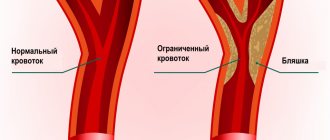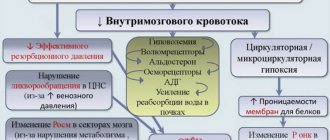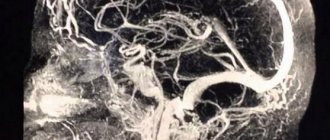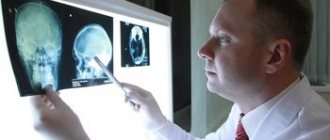A neurologist named common mistakes in the fight against migraine
When people in any country in the world are asked what spoils their health most often, the undisputed leader emerges: headaches. It can begin after vaccination against coronavirus and is painful when contracting covid. Pierces during strokes and torments during brain tumors. However, in the vast majority of cases, there are two types of so-called primary headaches, that is, not associated with other diseases (as opposed to secondary pain, for example, with tumors or vascular accidents). These are tension headaches and migraines. The latter, according to the World Health Organization, affects more than a billion people, or every seventh inhabitant of the Earth. Every September there is a special International Migraine Awareness Week. What scientists and doctors have learned about this scourge recently and what misconceptions about migraine and its treatment are most common today, Margarita Naprienko, the head physician of the Academician Wayne Clinic for Headache and Autonomic Disorders, neurologist, Doctor of Medical Sciences, Professor at Sechenov University, told reporters.
PROBLEM 1: THIS IS NOT A DISEASE “Traditionally, in Soviet times, and I was still in this period, we practically did not treat headaches,” says Professor Naprienko. - On the one hand, there was such a disease, everyone knew it. On the other hand, it was as if it did not exist, because our patients could not receive sick leave. There were common expressions like “Migraine - too lazy to work”, they are still tenacious. And many patients do not come to specialists for precisely this reason. According to epidemiological data, with episodic migraine, which occurs up to eight times a month, only every fourth person consults a doctor. If headaches occur more often, only half, every second, go to specialists.
In fact, migraine, of course, is a full-fledged independent disease, the expert explains. Although, even today this disease remains a mystery for scientists and doctors.
PROBLEM 2: WHERE DOES IT COME FROM - The final theory of the origin of migraine and the development of the attack has not been formed. Great steps have been taken in this direction; some of the processes are clear to specialists, but the mechanism has not yet been fully studied,” says Margarita Naprienko. “We know that there are people with a certain functioning of the brain: they are susceptible to easy arousal under the influence of a variety of provoking factors. Against the background of such provocateurs, certain neurochemical processes in the brain are triggered, during which the levels of various substances change. Among them is serotonin, popularly known as the “pleasure hormone.”
Under the influence of the ongoing processes during migraine, the so-called “cortical spreading depression” develops, the doctor continues. It manifests itself in a decrease in the electrical activity of brain cells. “This wave travels through the brain tissue, causing vasoconstriction, which leads to decreased blood flow to the brain. During this period, people may experience a headache precursor such as an aura (see details below), says the professor. “However, this wave passes quickly enough, and the vessels begin to expand. Inflammation develops in them, blood flows into the inflamed wall of the vessel, and during this period people begin to feel pain.”
With migraine with aura, a cascade of different neurological symptoms is observed before the headache attack.
- These may be changes in vision, sensitivity, speech impairment. But it is very important that these changes are reversible, that is, they can last from five minutes to an hour, and must pass without fail, emphasizes Dr. Naprienko. “When this happens for the first time, patients get very scared, and doctors can’t always figure it out. Such reversible symptoms may be mistaken for acute cerebrovascular accidents (stroke).
PROBLEM 3: THERE IS NO LIFE THREATENING, BUT ITS QUALITY IS RADICALLY DECREASING Migraine is not a life-threatening disease, explains Margarita Naprienko. And because of this, patients often encounter misunderstandings from acquaintances, loved ones, colleagues and employers.
- The person seems to be healthy, his arms and legs are in place, he stands, he can work from the point of view of others. And at the same time he says that he cannot do anything. I am not aware of any cases where employers fired people because of migraines in Russia. But families in which migraine caused serious problems in relationships met at the reception. It was even necessary to write ridiculous certificates stating that the patient might actually be poorly able to work or completely incapacitated for a certain period of time. And, accordingly, during this period they are recommended to have relative peace.
What will happen if you do not engage in special treatment for migraines, endure attacks, and in the case when they are completely unbearable, call an ambulance? This is the approach that most patients practice, the doctor confirms.
- Of course, you can endure it, understanding that the attack will end. But it’s one thing if a person is not burdened with anything, does not work, and has no children requiring supervision. Then, perhaps, he can lie down in a dark room and wait for the torment to pass. But if continuous vomiting and a bursting headache begin, then people call an ambulance. Alas, in fact, it cannot greatly alleviate the condition of migraines, explains Professor Naprienko. — Yes, against the background of severe pain, a person’s blood pressure may jump and panic may begin, then sedatives will be administered to normalize the pressure. But the ambulance does not have the resources to act on the pain attack itself during a migraine.
PROBLEM 4: HOW TO BE TREATED? There are two approaches, the expert says. For episodic migraines (attacks no more than 8 times a month), medications are used to relieve headache attacks. If migraine occurs frequently, then preventive therapy is prescribed - it makes attacks less frequent and reduces pain.
“It is impossible to completely recover from migraine, because it is a genetically determined disease,” explains Margarita Naprienko. “But today it is quite possible to make attacks rare and not severe, which most patients do not know about.
The gold standard for treating a migraine attack is taking aspirin, the professor continues. “Better than effervescent, always in a large dosage, 1,000 mg (pay attention to contraindications! - Ed.). Anti-nausea medications may also be added if present. Very often, during a migraine attack, medications are poorly absorbed in the stomach, and then we prescribe drugs that enhance peristalsis. And we recommend low doses of caffeine. This could be a cup of sweet tea, coffee or even Coca-Cola.
An important point: if a person has a headache, it is extremely undesirable to immediately take a pill, emphasizes Dr. Naprienko. The body has a system to counteract pain and it is quite possible that it will cope without allowing an attack to develop. The same tea, coffee or cola can help. Taking painkillers too often and too quickly can lead to the development of so-called drug-induced headaches, warns a neurologist.
- If an hour has passed and your head still hurts, then you need to take triptans. They were created specifically for the relief of migraine attacks and made a real revolution (the first medicine of this class was registered back in 1991 - Ed.). Just keep in mind that triptans cause vasoconstriction, so they are not recommended for use during a migraine aura (see above) - if a person develops this condition, it is advisable to take aspirin first. Perhaps it will allow you to avoid an attack altogether. If not, then after the aura disappears, a triptan is taken.
PROBLEM 5: ADDITION TO MEDICINES “Triptans, which quickly relieve an attack and return a person to work, have a peculiarity: if used incorrectly, addiction to them can quickly develop,” notes Professor Naprienko. “That’s why we always warn patients: they need to strictly control the amount of medications they take. As soon as the figure exceeds 8 doses per month for triptans and 10-12 for simple analgesics (aspirin, citramone, paracetamol, ibuprofen, etc.), this is a direct indication for contacting a specialist. So that the patient is prescribed adequate therapy and preventive treatment is selected.
If you continue to swallow painkillers in huge doses and in huge quantities, then the aforementioned drug-induced headache develops, and the person ends up in a vicious circle, the doctor explains.
For the treatment of frequent, chronic migraines, botulinum toxin type A drugs are used as a preventive treatment, as well as new generation drugs based on monoclonal antibodies. The latter appeared in our country quite recently, about a year ago, and only a doctor can select and prescribe them.
STAY IN THE KNOW How to recognize a migraine
To make a diagnosis, doctors interview the patient. You can check yourself yourself. Here are the main signs of migraine:
- headache attacks last from 4 to 72 hours and are repeated;
- pain has at least two characteristics from the list: strong, throbbing, one-sided, makes you move less (intensifies with bending over, physical activity);
- there is also at least one of these symptoms: nausea, irritation by light and (or) sounds.
Link to publication: kp.ru
Headache
Encephalitis
Tick-borne encephalitis
Polio
Hypercholesterolemia
21858 July 31
IMPORTANT!
The information in this section cannot be used for self-diagnosis and self-treatment.
In case of pain or other exacerbation of the disease, diagnostic tests should be prescribed only by the attending physician. To make a diagnosis and properly prescribe treatment, you should contact your doctor. Headache - causes, what diseases it occurs with, diagnosis and treatment methods. The basis of headaches is irritation of pain receptors located in:
- dura mater and cerebral vessels;
- periosteum of the skull, vessels of the soft tissues of the head, muscles.
The brain tissue itself does not contain pain receptors.
Types of headaches (cephalgia)
Headaches are divided into primary and secondary. A headache is considered primary if it is the main manifestation of a brain disease, such as in migraines and tension headaches.
Secondary headache is a symptom of other disorders, for example, head trauma, chronic cerebral ischemia, viral diseases, diseases of the cervical spine, etc.
Let's look at the four most common types of headaches.
Possible causes
Tension headache
Tension headache is the most common form of primary headache. Psycho-emotional stress, depression, anxiety and various phobias, overstrain of the muscles of the shoulder girdle - these are the main causes of tension headaches. Migraine headache
Migraines occur in women about three times more often than in men, and about 60-70% of all migraine cases in women are so-called menstrual migraines. However, the causes and mechanism of development of migraine attacks are not completely clear. At any age, in both men and women, migraine attacks can be provoked by emotional and physical overload, eating disorders, drinking alcohol, changes in weather conditions, sharp noise, strong odors, etc. Headache with colds
Headaches from colds are caused by hyperthermia and the damaging effects of microorganism toxins on brain cells. Headache in chronic cerebral ischemia
The cause of this pain, which is the most common secondary headache in elderly patients, is cerebral vascular pathology, in which blood circulation is disrupted and blood supply to brain tissue deteriorates.
The result is progressive brain dysfunction.
What diseases cause
tension headaches?
Tension headaches are caused by irritation of structures in the central nervous system (CNS) called the nociceptive system. Myogenic, stress, and psychogenic headaches are tension headaches.
Most often, tension headaches occur at a young and working age.
In cases of tension headaches, a person experiences bilateral, usually not strong, pressing and squeezing, monotonous and dull headaches. Attacks of such pain are accompanied by fatigue, nervousness, impaired appetite and sleep, and decreased performance. The duration of the attack is from 30 minutes to several days.
Migraine headache
Indicates only one disease - migraine, since attacks of such cephalgia have a peculiar character. Migraine pain is paroxysmal, throbbing, of moderate or severe intensity. It covers half of the head.
The pain may intensify with physical activity, tilting the head, and is often accompanied by nausea and vomiting.
Bright light, sharp sound, strong smell increase the pain. A migraine attack may be preceded by an aura, a collection of visual, auditory, olfactory or other neurological symptoms that lasts up to one hour.
Headache due to colds
Occurs in most acute and chronic diseases of the upper and lower respiratory tract caused by bacteria or viruses. In some cases, the intensity of such cephalgia correlates with the severity of fever, severity of cough, sore throat and other symptoms. The pain most often spreads throughout the head. Headache in chronic cerebral ischemia
The concept of chronic cerebral ischemia includes: discirculatory or vascular encephalopathy (slowly progressive cerebrovascular accident), cerebrovascular insufficiency (pathology of cerebral vessels), vascular dementia (a disorder that causes organic damage to the brain). In the clinical picture of chronic cerebral ischemia, dizziness, decreased cognitive function, emotional lability (unstable mood), motor-coordination disorders, and perception disorders (tinnitus, “floaters” before the eyes) become indispensable companions of headaches. Headaches are usually not severe, spread over the entire head, and last for a long time. Diagnostics and examinations
Tension headache and migraine headache, headache with colds
The diagnosis is made by a neurologist based on anamnesis and assessment of the patient’s complaints. Headache in chronic cerebral ischemia
Radiation examination is key for chronic cerebral ischemia (ultrasound Dopplerography of cerebral vessels)
What causes vascular spasms?
Cerebral vasospasm (another name for cerebral vascular spasm) can occur for various reasons. This is caused by problems not only in the brain, but also in the cervical region, where the arteries supply blood to the brain cells.
Prolonged severe fatigue, lack of sleep, oxygen starvation, poor blood supply significantly affect the condition of blood vessels, as do some vascular diseases.
The most common causes of cerebral vascular spasms:
- chronic stress and fatigue;
- lack of sleep and oxygen;
- nicotine;
- degeneration of vascular walls due to age-related changes.
Diseases that provoke spasm of cerebral vessels:
- cervical osteochondrosis;
- hypertension;
- VSD;
- renal disorders;
- tumors.
Such serious factors are not the only culprits in the occurrence of spasm symptoms. A sharp constriction of blood vessels can occur, for example, when cooling the head without a hat, taking a large dose of alcohol, or a sudden surge of emotions (including positive ones). If earlier the disease was considered age-related, when the vessels lost elasticity and changed due to natural patterns, today the pathology has become significantly “younger”, becoming a frequent companion of residents of megacities, where the ecology, rhythm of life, and air pollution leave much to be desired.
At-risk groups
Spasm of cerebral vessels threatens certain categories of people whose body is least protected from the problem. Most often these are individuals with certain diseases or a sensitive vascular system:
- suffered a heart attack, stroke;
- diabetics;
- hypertensive patients;
- those suffering from angina pectoris;
- prone to thrombosis;
- mentally unstable;
- persons who react acutely to changes in atmospheric pressure.
Treat without maiming. Neurologist on how to properly deal with headaches
Instead of drinking handfuls of painkillers and convincing yourself that the pain will go away, think about why exactly you have a headache and whether you are already dependent on pills.
There is hardly a person in your circle who has not had a headache at least once in their life. How to distinguish dangerous pain from non-dangerous? When is it not necessary to take medication? Who is at risk of getting hooked on pills?
Five important questions about AiF headaches were answered by the head of the Pain Clinic of City Clinical Hospital No. 1 named after. N.I. Pirogova, neurologist Ekaterina Abramova.
Is it possible to endure a headache and do without pills?
If a headache interferes with your work responsibilities or household chores, then you don’t need to endure it, you should take a painkiller. However, there are situations when even with a seemingly ordinary headache, it is necessary to consult a doctor, and not try to relieve it with analgesics yourself.
There are four criteria for a dangerous headache, accepted by leading experts around the world. Everyone needs to know them.
1. Did your headache first appear after you were 50 years old? This is most often a sign of a serious illness.
2. Did your head hurt suddenly and very badly? Such pain may be a symptom of intracerebral hemorrhage.
3. Does the headache gradually increase, become stronger, and last for several days or even weeks? This is how the first attack of migraine, the development of a tumor or an infectious process in the brain (meningitis, encephalitis, etc.) may manifest itself. The infection may be accompanied by symptoms of general malaise, in particular high fever and weakness. But sometimes there is only one symptom: headache.
4. Is the headache accompanied by nausea or impaired consciousness (fainting, confusion, the person seems to be inhibited, loses orientation, etc.) or is it significantly worsened by coughing and sneezing? This condition indicates that there is increased intracranial pressure. The cause may be a tumor or problems with the cerebrospinal fluid that washes the brain (impaired circulation, increased or decreased production, etc.).
Any of the listed symptoms indicates that you need to consult a specialist.
What to do if your head hurts often?
Of course, in the case of chronic pain, when the headache is frequent and severe, because of which a person is forced to constantly increase the dose of painkillers, it is also necessary to go to the doctor. Otherwise, there is a high risk of acquiring a drug-dependent headache. Such a headache will not go away on its own; it will require an increasingly larger dose of pills. And they, in turn, can provoke complications from the cardiovascular system, for example, a tendency to thrombosis, or cause an exacerbation of peptic ulcer disease, in severe cases even gastrointestinal bleeding.
Here again there is a clear criterion. If you take more than 15 tablets a month specifically for headaches (this can be calculated from the purchased packages), it means that you have developed a dependence on medications. You should definitely contact a neurologist or cephalgologist: this is also a neurologist who has undergone special training in the treatment of headaches. Young working women with a family often come to our clinic with a similar problem: they cannot afford to endure a headache, but do not have time to take care of their health, start taking painkillers, and even go so far as to take several tablets a day. However, the headache continues to hurt, sleep is disturbed, and overall health worsens. In this case, a detoxification course is carried out for a week, sometimes with the installation of intravenous drips, and special medications are prescribed to relieve headaches. As a result, the dosage of painkillers is gradually reduced, and over time the headache itself stops.
How to choose painkillers?
Everything here is individual. For some people, regular paracetamol or ibuprofen helps with headaches. For others they are useless. There are more modern drugs that do not have such a negative effect on the wall of the gastrointestinal tract and generally cause fewer side effects.
The most reasonable approach is to choose a painkiller together with your doctor, especially if you have, for example, chronic gastritis, if the patient is over 40 years old.
Is it possible to get rid of headaches without medications using home remedies?
Yes, but not always. For example, against migraine (unilateral pain, often in the eye area or behind the eye, pulsating, gradually increases and lasts from 4 to 72 hours), there are no “folk” remedies. An adequate course of drug treatment is necessary.
If the headache is caused by increased blood pressure, then you need to take a blood pressure lowering drug (not a painkiller). If you have a headache, you should first measure your blood pressure before taking pills for pain.
But headaches associated with overexertion can be relieved with non-drug methods. Often the head starts to hurt due to improper posture. For example, a person works at a computer for a long time, sits in the wrong position: his shoulders are raised, his head is moved slightly forward. As a result, the neck muscles become overstrained and produce a characteristic nagging headache, not very strong, but debilitating. In this case, simple exercises to stretch the neck muscles and massage help a lot. You can even just get up from your desk, move around, and the pain will go away.
Often a headache occurs towards the end of the work week. Especially if you have a busy schedule and the person did not get enough sleep, did not eat very well, etc. In this case, you need to first of all get enough sleep (healthy sleep is extremely important for a person with a headache). You can take a hot bath, if there is no high blood pressure, drink green tea, and take a walk in the fresh air. In general, if it is possible not to take pills, it is better not to do so.
What to do if you have a headache after being in the sun for a long time?
When exposed to the sun for a long time, the headache most often occurs due to fluid loss. In the sun, a person sweats much more than usual, especially if he moves or swims in the pool. At the same time, the amount of water you drink often remains the same as on days when there is much less sun. As a result, a headache occurs. In this case, preventive measures are most effective. During a long walk on a sunny day, drink enough water, use hats, umbrellas, and be sure to wear sunglasses. Eye strain, such as squinting into the sun, can also make headaches worse.
If a headache has already appeared after prolonged exposure to the sun, then be sure to drink water, preferably mineral water, to replenish the loss of electrolytes. You can take a cool shower, wash your hair, that is, cool your body. When you can’t take a shower, you can wet a towel with cool water, put it on your head and lie there for a while. If the headache does not go away from such general activities, you can take a painkiller tablet: paracetamol, acetylsalicylic acid, or any non-steroidal anti-inflammatory drug that is in the medicine cabinet. However, if the headache after returning from a sunny beach is very strong, coordination is impaired, and dizziness appears, this indicates severe loss of fluid, an increase or a sharp decrease in blood pressure. In this situation, it is imperative to move the person to the shade, carry out all cooling measures, and give him a painkiller tablet to drink. If symptoms persist, you should definitely consult a doctor so as not to miss a more serious disease.
Source of information: “Arguments and Facts”








